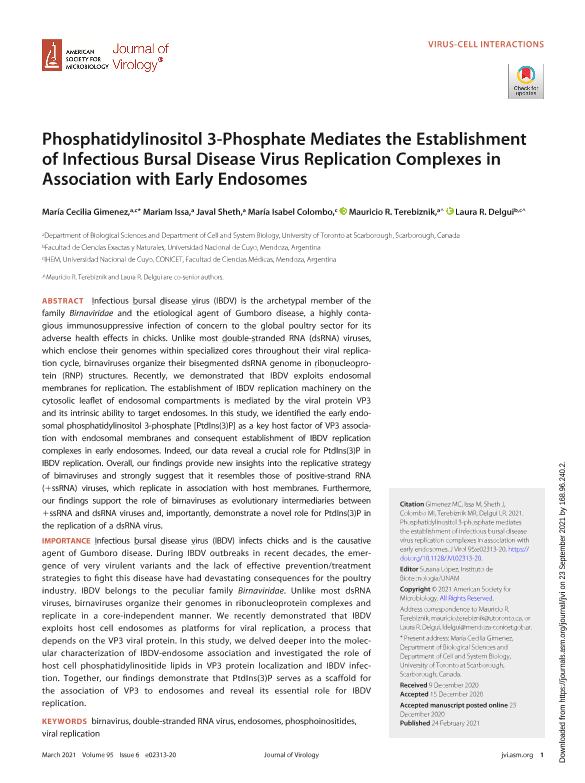Mostrar el registro sencillo del ítem
dc.contributor.author
Gimenez, Maria Cecilia

dc.contributor.author
Issa, Mariam
dc.contributor.author
Sheth, Javal
dc.contributor.author
Colombo, Maria Isabel

dc.contributor.author
Terebiznik, Mauricio R.
dc.contributor.author
Delgui, Laura Ruth

dc.date.available
2021-09-23T13:49:07Z
dc.date.issued
2021-02
dc.identifier.citation
Gimenez, Maria Cecilia; Issa, Mariam; Sheth, Javal; Colombo, Maria Isabel; Terebiznik, Mauricio R.; et al.; Phosphatidylinositol 3-phosphate mediates the establishment of infectious bursal disease virus replication complexes in association with early endosomes; American Society for Microbiology; Journal of Virology; 95; 6; 2-2021; 1-20
dc.identifier.issn
0022-538X
dc.identifier.uri
http://hdl.handle.net/11336/141333
dc.description.abstract
Infectious bursal disease virus (IBDV) is the archetypal member of the family Birnaviridae and the etiological agent of Gumboro disease, a highly contagious immunosuppressive infection of concern to the global poultry sector for its adverse health effects in chicks. Unlike most double-stranded RNA (dsRNA) viruses, which enclose their genomes within specialized cores throughout their viral replication cycle, birnaviruses organize their bisegmented dsRNA genome in ribonucleoprotein (RNP) structures. Recently, we demonstrated that IBDV exploits endosomal membranes for replication. The establishment of IBDV replication machinery on the cytosolic leaflet of endosomal compartments is mediated by the viral protein VP3 and its intrinsic ability to target endosomes. In this study, we identified the early endosomal phosphatidylinositol 3-phosphate [PtdIns(3)P] as a key host factor of VP3 association with endosomal membranes and consequent establishment of IBDV replication complexes in early endosomes. Indeed, our data reveal a crucial role for PtdIns(3)P in IBDV replication. Overall, our findings provide new insights into the replicative strategy of birnaviruses and strongly suggest that it resembles those of positive-strand RNA (1ssRNA) viruses, which replicate in association with host membranes. Furthermore, our findings support the role of birnaviruses as evolutionary intermediaries between 1ssRNA and dsRNA viruses and, importantly, demonstrate a novel role for PtdIns(3)P in the replication of a dsRNA virus. IMPORTANCE Infectious bursal disease virus (IBDV) infects chicks and is the causative agent of Gumboro disease. During IBDV outbreaks in recent decades, the emergence of very virulent variants and the lack of effective prevention/treatment strategies to fight this disease have had devastating consequences for the poultry industry. IBDV belongs to the peculiar family Birnaviridae. Unlike most dsRNA viruses, birnaviruses organize their genomes in ribonucleoprotein complexes and replicate in a core-independent manner. We recently demonstrated that IBDV exploits host cell endosomes as platforms for viral replication, a process that depends on the VP3 viral protein. In this study, we delved deeper into the molecular characterization of IBDV-endosome association and investigated the role of host cell phosphatidylinositide lipids in VP3 protein localization and IBDV infection. Together, our findings demonstrate that PtdIns(3)P serves as a scaffold for the association of VP3 to endosomes and reveal its essential role for IBDV replication.
dc.format
application/pdf
dc.language.iso
eng
dc.publisher
American Society for Microbiology

dc.rights
info:eu-repo/semantics/openAccess
dc.rights.uri
https://creativecommons.org/licenses/by-nc-sa/2.5/ar/
dc.subject
BIRNAVIRUS
dc.subject
DOUBLE-STRANDED RNA VIRUS
dc.subject
ENDOSOMES
dc.subject
PHOSPHOINOSITIDES
dc.subject
VIRAL REPLICATION
dc.subject.classification
Virología

dc.subject.classification
Ciencias Biológicas

dc.subject.classification
CIENCIAS NATURALES Y EXACTAS

dc.title
Phosphatidylinositol 3-phosphate mediates the establishment of infectious bursal disease virus replication complexes in association with early endosomes
dc.type
info:eu-repo/semantics/article
dc.type
info:ar-repo/semantics/artículo
dc.type
info:eu-repo/semantics/publishedVersion
dc.date.updated
2021-09-06T19:57:17Z
dc.journal.volume
95
dc.journal.number
6
dc.journal.pagination
1-20
dc.journal.pais
Estados Unidos

dc.journal.ciudad
Washington
dc.description.fil
Fil: Gimenez, Maria Cecilia. Consejo Nacional de Investigaciones Científicas y Técnicas. Centro Científico Tecnológico Conicet - Mendoza. Instituto de Histología y Embriología de Mendoza Dr. Mario H. Burgos. Universidad Nacional de Cuyo. Facultad de Ciencias Médicas. Instituto de Histología y Embriología de Mendoza Dr. Mario H. Burgos; Argentina. University of Toronto; Canadá
dc.description.fil
Fil: Issa, Mariam. University of Toronto; Canadá
dc.description.fil
Fil: Sheth, Javal. University of Toronto; Canadá
dc.description.fil
Fil: Colombo, Maria Isabel. Consejo Nacional de Investigaciones Científicas y Técnicas. Centro Científico Tecnológico Conicet - Mendoza. Instituto de Histología y Embriología de Mendoza Dr. Mario H. Burgos. Universidad Nacional de Cuyo. Facultad de Ciencias Médicas. Instituto de Histología y Embriología de Mendoza Dr. Mario H. Burgos; Argentina
dc.description.fil
Fil: Terebiznik, Mauricio R.. University of Toronto; Canadá
dc.description.fil
Fil: Delgui, Laura Ruth. Consejo Nacional de Investigaciones Científicas y Técnicas. Centro Científico Tecnológico Conicet - Mendoza. Instituto de Histología y Embriología de Mendoza Dr. Mario H. Burgos. Universidad Nacional de Cuyo. Facultad de Ciencias Médicas. Instituto de Histología y Embriología de Mendoza Dr. Mario H. Burgos; Argentina
dc.journal.title
Journal of Virology

dc.relation.alternativeid
info:eu-repo/semantics/altIdentifier/url/http://jvi.asm.org/lookup/doi/10.1128/JVI.02313-20
dc.relation.alternativeid
info:eu-repo/semantics/altIdentifier/doi/http://dx.doi.org/10.1128/JVI.02313-20
Archivos asociados
